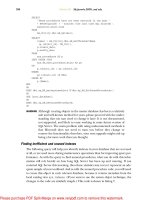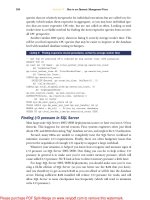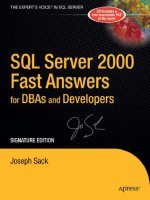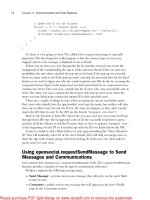Tài liệu SQL Puzzles & Answers- P3 pptx
Bạn đang xem bản rút gọn của tài liệu. Xem và tải ngay bản đầy đủ của tài liệu tại đây (384.72 KB, 40 trang )
62 PUZZLE 15 FIND THE LAST TWO SALARIES
employee. If the programmers were not so lazy, you could pass this table
to them and let them format it for the report.
Answer #2
The real problem is harder. One way to do this within the limits of SQL-
89 is to break the problem into two cases:
1. Employees with only one salary action
2. Employees with two or more salary actions
We know that every employee has to fall into one and only one of
those cases. One solution is to
UNION both of the sets together:
SELECT S0.emp_name, S0.sal_date, S0.sal_amt, S1.sal_date,
S1.sal_amt
FROM Salaries AS S0, Salaries AS S1
WHERE S0.emp_name = S1.emp_name
AND S0.sal_date =
(SELECT MAX(S2.sal_date)
FROM Salaries AS S2
WHERE S0.emp_name = S2.emp_name)
AND S1.sal_date =
(SELECT MAX(S3.sal_date)
FROM Salaries AS S3
WHERE S0.emp_name = S3.emp_name
AND S3.sal_date < S0.sal_date)
UNION ALL
SELECT S4.emp_name, MAX(S4.sal_date), MAX(S4.sal_amt),
NULL, NULL
FROM Salaries AS S4
GROUP BY S4.emp_name
HAVING COUNT(*) = 1;
emp_name sal_date sal_amt sal_date sal_amt
========================================================
'Tom' '1996-12-20' 900.00 '1996-10-20' 800.00
'Harry' '1996-09-20' 700.00 '1996-07-20' 500.00
'Dick' '1996-06-20' 500.00 NULL NULL
Please purchase PDF Split-Merge on www.verypdf.com to remove this watermark.
PUZZLE 15 FIND THE LAST TWO SALARIES 63
DB2 programmers will recognize this as a version of the OUTER JOIN
done without an SQL-92 standard
OUTER JOIN operator. The first
SELECT statement is the hardest. It is a self-join on the Salaries table,
with copy
S0 being the source for the most recent salary information and
copy
S1 the source for the next most recent information. The second
SELECT statement is simply a grouped query that locates the employees
with one row. Since the two result sets are disjoint, we can use the
UNION
ALL
instead of a UNION operator to save an extra sorting operation.
Answer #3
I got several answers in response to my challenge for a better solution
to this puzzle. Richard Romley of Smith Barney sent in the following
SQL-92 solution. It takes advantage of the subquery table expression
to avoid
VIEWs:
SELECT B.emp_name, B.maxdate, Y.sal_amt, B.maxdate2,
Z.sal_amt
FROM (SELECT A.emp_name, A.maxdate, MAX(X.sal_date) AS
maxdate2
FROM (SELECT W.emp_name, MAX(W.sal_date) AS
maxdate
FROM Salaries AS W
GROUP BY W.emp_name) AS A
LEFT OUTER JOIN Salaries AS X
ON A.emp_name = X.emp_name
AND A.maxdate > X.sal_date
GROUP BY A.emp_name, A.maxdate) AS B
LEFT OUTER JOIN Salaries AS Y
ON B.emp_name = Y.emp_name
AND B.maxdate = Y.sal_date
LEFT OUTER JOIN Salaries AS Z
ON B.emp_name = Z.emp_name
AND B.maxdate2 = Z.sal_date;
If your SQL product supports common table expressions (CTEs), you
can convert some of the subqueries into
VIEWs for the table subqueries
named
A and B.
Please purchase PDF Split-Merge on www.verypdf.com to remove this watermark.
64 PUZZLE 15 FIND THE LAST TWO SALARIES
Answer #4
Mike Conway came up with an answer in Oracle, which I tried to
translate into SQL-92 with mixed results. The problem with the
translation was that the Oracle version of SQL did not support the SQL-
92 standard
OUTER JOIN syntax, and you have to watch the order of
execution to get the right results. Syed Kadir, an associate application
engineer at Oracle, sent in an improvement on my answer using the
VIEW that was created in the first solution:
SELECT S1.emp_name, S1.sal_date, S1.sal_amt, S2.sal_date,
S2.sal_amt
FROM Salaries1 AS S1, Salaries2 AS S2 use the view
WHERE S1.emp_name = S2.emp_name
AND S1.sal_date > S2.sal_date
UNION ALL
SELECT emp_name, MAX(sal_date), MAX(sal_amt), NULL, NULL
FROM Salaries1
GROUP BY emp_name
HAVING COUNT(*) = 1;
You might have to replace the last two columns with the expressions
CAST (NULL AS DATE) and CAST(NULL AS DECIMAL(8,2)) to assure
that they are of the right datatypes for a
UNION.
Answer #5
Jack came up with a solution using the relational algebra operators as
defined in one of Chris Date’s books on the www.dbdebunk.com Web
site, which I am not going to post, since (1) the original problem was to
be done in Oracle, and (2) nobody has implemented Relational Algebra.
There is an experimental language called Tutorial D based on Relational
Algebra, but it is not widely available.
The problem with the solution was that it created false data. All
employees without previous salary records were assigned a previous
salary of
0.00 and a previous salary date of '1900-01-01', even
though zero and no value are logically different and the universe did
not start in 1900.
Fabian Pascal commented that “This was a very long time ago and I
do not recall the exact circumstances, and whether my reply was
properly represented or understood (particularly coming from Celko).
Please purchase PDF Split-Merge on www.verypdf.com to remove this watermark.
PUZZLE 15 FIND THE LAST TWO SALARIES 65
My guess is that it had something to do with inability to resolve such
problems without a precise definition of the tables to which the query is
to be applied, the business rules in effect for the tables, and the query at
issue. I will let Chris Date to respond to PV’s solution.”
Chris Date posted a solution in his private language that was more
compact than Jack’s solution, and that he evaluated was “Tedious, but
essentially straightforward,” along with the remark “Regarding whether
Celko’s solution is correct or not, I neither know, nor care.”
A version that replaces the outer join with a
COALESCE() by Andrey
Odegov:
SELECT S1.emp_name_id, S1.sal_date AS curr_date, S1.sal_amt
AS
curr_amt,
CASE WHEN S2.sal_date <> S1.sal_date THEN S2.sal_date
END AS
prev_date,
CASE WHEN S2.sal_date <> S1.sal_date THEN S2.sal_amt
END AS
prev_amt
FROM Salaries AS S1
INNER JOIN Salaries AS S2
ON S2.emp_name_id = S1.emp_name_id
AND S2.sal_date = COALESCE((SELECT MAX(S4.sal_date)
FROM Salaries AS S4
WHERE S4.emp_name_id =
S1.emp_name_id
AND S4.sal_date <
S1.sal_date),
S2.sal_date)
WHERE NOT EXISTS(SELECT *
FROM Salaries AS S3
WHERE S3.emp_name_id = S1.emp_name_id
AND S3.sal_date > S1.sal_date);
Answer #6
One approach is to build a VIEW or CTE that gives all possible pairs of
salary dates, and then filter them:
CREATE VIEW SalaryHistory (curr_date, curr_amt, prev_date,
prev_amt)
Please purchase PDF Split-Merge on www.verypdf.com to remove this watermark.
66 PUZZLE 15 FIND THE LAST TWO SALARIES
AS
SELECT S0.emp_name_id, S0.sal_date AS curr_date,
S0.sal_amt AS curr_amt,
S1.sal_date AS prev_date,
S1.sal_amt AS prev_amt
FROM Salaries AS S0
LEFT OUTER JOIN
Salaries AS S1
ON S0.emp_name_id = S1.emp_name_id
AND S0.sal_date > S1.sal_date;
then use it in a self-join query:
SELECT S0.emp_name_id, S0.curr_date, S0.curr_amt,
S0.prev_date, S0.prev_amt
FROM SalaryHistory AS S0
WHERE S0.curr_date
= (SELECT MAX(curr_date)
FROM SalaryHistory AS S1
WHERE S0.emp_name_id = S1.emp_name_id)
AND (S0.prev_date
= (SELECT MAX(prev_date)
FROM SalaryHistory AS S2
WHERE S0.emp_name_id = S2.emp_name_id)
OR S0.prev_date IS NULL)
This is still complex, but that view might be useful for computing
other statistics.
Answer #7
Here is another version of the VIEW approach from MarkC600 on the
SQL Server Newsgroup. The
OUTER JOIN has been replaced with a
RANK() function from SQL:2003. Study this and see how the thought
pattern is changing:
WITH SalaryRanks(emp_name, sal_date, sal_amt, pos)
AS
(SELECT emp_name, sal_date, sal_amt,
RANK() OVER(PARTITION BY emp_name ORDER BY sal_date
DESC)
Please purchase PDF Split-Merge on www.verypdf.com to remove this watermark.
PUZZLE 15 FIND THE LAST TWO SALARIES 67
FROM Salaries)
SELECT C.emp_name,
C.sal_date AS curr_date, C.sal_amt AS curr_amt,
P.sal_date AS prev_date, P.sal_amt AS prev_amt
FROM SalaryRanks AS C
LEFT OUTER JOIN
SalaryRanks AS P
ON P.emp_name = C.emp_name
AND P.pos = 2
WHERE C.pos = 1;
Answer #8
Here is an SQL:2003 version, with OLAP functions and SQL-92 CASE
expressions from Dieter Noeth:
SELECT S1.emp_name,
MAX (CASE WHEN rn = 1 THEN sal_date ELSE NULL END) AS
curr_date,
MAX (CASE WHEN rn = 1 THEN sal_amt ELSE NULL END) AS
curr_amt,
MAX (CASE WHEN rn = 2 THEN sal_date ELSE NULL END) AS
prev_date,
MAX (CASE WHEN rn = 2 THEN sal_amt ELSE NULL END) AS
prev_amt,
FROM (SELECT emp_name, sal_date, sal_amt,
RANK()OVER (PARTITION BY S1.emp_name ORDER BY
sal_date DESC)
FROM Salaries) AS S1 (emp_name, sal_date, sal_amt,
rn)
WHERE rn < 3
GROUP BY S1.emp_name;
The idea is to number the rows within each employee and then to
pull out the two most current values for the employment date. The other
approaches build all the target output rows first and then find the ones
we want. This query finds the raw rows first and puts them together last.
The table is used only once, no self-joins, but a hidden sort will be
required for the
RANK() function. This is probably not a problem in SQL
engines that use contiguous storage or have indexing that will group the
employee names together.
Please purchase PDF Split-Merge on www.verypdf.com to remove this watermark.
68 PUZZLE 15 FIND THE LAST TWO SALARIES
Answer #9
Here is another answer from Dieter Noeth using OLAP/CTE (tested on
Teradata, but runs on MS-SQL 2005, too):
WITH CTE (emp_name, sal_date, sal_amt, rn)
AS
(SELECT emp_name, sal_date, sal_amt ,
ROW_NUMBER() OVER (PARTITION BY emp_name
ORDER BY sal_date DESC) AS rn – row numbering
FROM Salaries)
SELECT O.emp_name,
O.sal_date AS curr_date, O.sal_amt AS curr_amt,
I.sal_date AS prev_date, I.sal_amt AS prev_amt
FROM CTE AS O
LEFT OUTER JOIN
CTE AS I
ON O.emp_name = I.emp_name AND I.rn = 2
WHERE O.rn = 1;
Again, SQL:2003 using OLAP functions in Teradata:
SELECT emp_name, curr_date, curr_amt,
prev_date, prev_amt
FROM (SELECT emp_name,
sal_date AS curr_date, sal_amt AS curr_amt,
MIN(sal_date)
OVER (PARTITION BY emp_name
ORDER BY sal_date DESC
ROWS BETWEEN 1 FOLLOWING AND 1 FOLLOWING)
AS prev_date,
MIN(sal_amt)
OVER (PARTITION BY emp_name
ORDER BY sal_date DESC
ROWS BETWEEN 1 FOLLOWING AND 1 FOLLOWING)
AS prev_amt,
ROW_NUMBER() OVER (PARTITION BY emp_name ORDER BY
sal_date DESC) AS rn
FROM Salaries) AS DT
WHERE rn = 1;
This query would be easier if Teradata supported the WINDOW clause.
Please purchase PDF Split-Merge on www.verypdf.com to remove this watermark.
PUZZLE 16 MECHANICS 69
PUZZLE
16 MECHANICS
Gerard Manko at ARI posted this problem on CompuServe in April
1994. ARI had just switched over from Paradox to Watcom SQL (now
part of Sybase). The conversion of the legacy database was done by
making each Paradox table into a Watcom SQL table, without any
thought of normalization or integrity rules—just copy the column
names and data types. Yes, I know that as the SQL guru, I should have
sent him to that ring of hell reserved for people who do not normalize,
but that does not get the job done, and ARI’s approach is something I
find in the real world all the time.
The system tracks teams of personnel to work on jobs. Each job has a
slot for a single primary mechanic and a slot for a single optional
assistant mechanic. The tables involved look like this:
CREATE TABLE Jobs
(job_id INTEGER NOT NULL PRIMARY KEY,
start_date DATE NOT NULL,
);
CREATE TABLE Personnel
(emp_id INTEGER NOT NULL PRIMARY KEY,
emp_name CHAR(20) NOT NULL,
);
CREATE TABLE Teams
(job_id INTEGER NOT NULL,
mech_type INTEGER NOT NULL,
emp_id INTEGER NOT NULL,
);
Your first task is to add some integrity checking into the Teams table.
Do not worry about normalization or the other tables for this problem.
What you want to do is build a query for a report that lists all the jobs
by
job_id, the primary mechanic (if any), and the assistant mechanic (if
any). Here are some hints: You can get the
job_ids from Jobs because
that table has all of the current jobs, while the
Teams table lists only
those jobs for which a team has been assigned. The same person can be
assigned as both a primary and assistant mechanic on the same job.
Please purchase PDF Split-Merge on www.verypdf.com to remove this watermark.
70 PUZZLE 16 MECHANICS
Answer #1
The first problem is to add referential integrity. The Teams table should
probably be tied to the others with
FOREIGN KEY references, and it is
always a good idea to check the codes in the database schema, as
follows:
CREATE TABLE Teams
(job_id INTEGER NOT NULL REFERENCES Jobs(job_id),
mech_type CHAR(10) NOT NULL
CHECK (mech_type IN ('Primary', 'Assistant')),
emp_id INTEGER NOT NULL REFERENCES Personnel(emp_id),
);
Experienced SQL people will immediately think of using a LEFT
OUTER JOIN
, because to get the primary mechanics only, you could
write:
SELECT Jobs.job_id, Teams.emp_id AS “primary”
FROM Jobs LEFT OUTER JOIN Teams
ON Jobs.job_id = Teams.job_id
WHERE Teams.mech_type = 'Primary';
You can do a similar OUTER JOIN to the Personnel table to tie it to
Teams, but the problem here is that you want to do two independent
outer joins for each mechanic’s slot on a team, and put the results in one
table. It is probably possible to build a horrible, deeply nested self
OUTER
JOIN
all in one SELECT statement, but you would not be able to read or
understand it.
You could do the report with views for primary and assistant
mechanics, and then put them together, but you can avoid all of this
mess with the following query:
SELECT Jobs.job_id,
(SELECT emp_id
FROM Teams
WHERE Jobs.job_id = Teams.job_id
AND Teams.mech_type = 'Primary') AS "primary",
(SELECT emp_id
FROM Teams
WHERE Jobs.job_id = Teams.job_id
Please purchase PDF Split-Merge on www.verypdf.com to remove this watermark.
PUZZLE 16 MECHANICS 71
AND Teams.mech_type = 'Assistant') AS assistant
FROM Jobs;
The reason that “primary” is in double quotation marks is that it is a
reserved word in SQL-92, as in
PRIMARY KEY. The double quotation
marks make the word into an identifier. When the same word is in single
quotation marks, it is treated as a character string.
One trick is the ability to use two independent scalar
SELECT
statements in the outermost
SELECT. To add the employee’s name,
simply change the innermost
SELECT statements.
SELECT Jobs.job_id,
(SELECT name
FROM Teams, Personnel
WHERE Jobs.job_id = Teams.job_id
AND Personnel.emp_id = Teams.emp_id
AND Teams.mech_type = 'Primary') AS “primary",
(SELECT name
FROM Teams, Personnel
WHERE Jobs,job_id = Teams,job_id
AND Personnel.emp_id = Teams.emp_id
AND Teams.mech_type = 'Assistant') AS Assistant
FROM Jobs:
If you have an employee acting as both primary and assistant
mechanic on a single job, then you will get that employee in both slots. If
you have two or more primary mechanics or two or more assistant
mechanics on a job, then you will get an error, as you should. If you have
no primary or assistant mechanic, then you will get an empty
SELECT
result, which becomes a
NULL. That gives you the outer joins you wanted.
Answer #2
Skip Lees of Chico, California, wanted to make the Teams table enforce
the rules that:
1. A
job_id has zero or one primary mechanics.
2. A
job_id has zero or one assistant mechanics.
3. A
job_id always has at least one mechanic of some kind.
Please purchase PDF Split-Merge on www.verypdf.com to remove this watermark.
72 PUZZLE 16 MECHANICS
Based on rule 3, there should be no time at which a job has no team
members. On the face of it, this makes sense.
Therefore, team information will have to be entered before job
records. Using a referential integrity constraint will enforce this
constraint. Restrictions 1 and 2 can be enforced by making “
job_id” and
“
mech_type” into a two-column PRIMARY KEY, so that a job_id could
never be entered more than once with a given
mech_type.
CREATE TABLE Jobs
(job_id INTEGER NOT NULL PRIMARY KEY REFERENCES Teams
(job_id),
start_date DATE NOT NULL,
);
CREATE TABLE Teams
(job_id INTEGER NOT NULL,
mech_type CHAR(10) NOT NULL
CHECK (mech_type IN ('Primary', 'Assistant')),
emp_id INTEGER NOT NULL REFERENCES Personnel(emp_id),
PRIMARY KEY (job_id, mech_type));
There is a subtle “gotcha” in this problem. SQL-92 says that a
REFERENCES clause in the referencing table has to reference a UNIQUE or
PRIMARY KEY column set in the referenced table. That is, the reference is
to be to the same number of columns of the same datatypes in the same
order. Since we have a
PRIMARY KEY, (job_id, mech_type) is available
in the Teams table in your answer.
Therefore, the
job_id column in the Jobs table by itself cannot
reference just the
job_id column in the Teams table. You could get
around this with a
UNIQUE constraint:
CREATE TABLE Teams
(job_id INTEGER NOT NULL UNIQUE,
mech_type CHAR(10) NOT NULL
CHECK (mech_type IN ('Primary', 'Assistant')),
PRIMARY KEY (job_id, mech_type));
but it might be more natural to say:
Please purchase PDF Split-Merge on www.verypdf.com to remove this watermark.
PUZZLE 16 MECHANICS 73
CREATE TABLE Teams
(job_id INTEGER NOT NULL PRIMARY KEY,
mech_type CHAR(10) NOT NULL
CHECK (mech_type IN ('primary', 'assistant')),
UNIQUE (job_id, mech_type));
because job_id is what identifies the entity that is represented by the
table. In actual SQL implementations, the
PRIMARY KEY declaration can
affect data storage and access methods, so the choice could make a
practical difference in performance.
But look at what we have done! I cannot have both “
primary” and
“
assistant” mechanics on one job because this design would require
job_id to be unique.
Answer #3
Having primary and assistant mechanics is a property of a team on a job,
so let’s fix the schema:
CREATE TABLE Teams
(job_id INTEGER NOT NULL REFERENCES Jobs(job_id),
primary_mech INTEGER NOT NULL
REFERENCES Personnel(emp_id),
assist_mech INTEGER NOT NULL
REFERENCES Personnel(emp_id),
CONSTRAINT at_least_one_mechanic
CHECK(COALESCE (primary_mech, assist_mech) IS NOT NULL),
);
But this is not enough; we want to be sure that only qualified
mechanics hold those positions:
CREATE TABLE Personnel
(emp_id INTEGER NOT NULL PRIMARY KEY,
mech_type CHAR(10) NOT NULL
CHECK (mech_type IN ('Primary', 'Assistant')),
UNIQUE (emp_id, mech_type),
);
So change the Teams again:
Please purchase PDF Split-Merge on www.verypdf.com to remove this watermark.
74 PUZZLE 16 MECHANICS
CREATE TABLE Teams
(job_id INTEGER NOT NULL REFERENCES Jobs(job_id),
primary_mech INTEGER NOT NULL,
primary_type CHAR(10) DEFAULT ‘Primary’ NOT NULL
CHECK (primary_type = ‘Primary’)
REFERENCES Personnel(emp_id, mech_type),
assist_mech INTEGER NOT NULL
assist_type CHAR(10) DEFAULT ‘Assistant’ NOT NULL
CHECK (assist_type = ‘Assistant’)
REFERENCES Personnel(emp_id, mech_type),
CONSTRAINT at_least_one_mechanic
CHECK(COALESCE (primary_mech, assist_mech) IS NOT NULL),
);
Now it should work.
Please purchase PDF Split-Merge on www.verypdf.com to remove this watermark.
PUZZLE 17 EMPLOYMENT AGENCY 75
PUZZLE
17 EMPLOYMENT AGENCY
Larry Wade posted a version of this problem on the Microsoft ACCESS
forum at the end of February 1996. He is running an employment
service that has a database with tables for job orders, candidates, and
their job skills. He is trying to do queries to match candidates to job
orders based on their skill. The job orders take the form of a Boolean
expression connecting skills. For example, find all candidates with
manufacturing and inventory or accounting skills.
First, let’s construct a table of the candidate’s skills. You can assume
that personal information about the candidate is in another table, but we
will not bother with it for this problem.
CREATE TABLE CandidateSkills
(candidate_id INTEGER NOT NULL,
skill_code CHAR(15) NOT NULL,
PRIMARY KEY (candidate_id, skill_code));
INSERT INTO CandidateSkills
VALUES ((100, 'accounting'),
(100, 'inventory'),
(100, 'manufacturing'),
(200, 'accounting'),
(200, 'inventory'),
(300, 'manufacturing'),
(400, 'inventory'),
(400, 'manufacturing'),
(500, 'accounting'),
(500, 'manufacturing'));
The obvious solution would be to create dynamic SQL queries in a
front-end product for each job order, such as:
SELECT candidate_id, 'job_id #212' constant job id code
FROM CandidateSkills AS C1, one correlation per skill
CandidateSkills AS C2,
CandidateSkills AS C3
WHERE C1.candidate_id = C2.candidate_id
AND C1.candidate_id = C3.candidate_id
AND job order expression created here
Please purchase PDF Split-Merge on www.verypdf.com to remove this watermark.
76 PUZZLE 17 EMPLOYMENT AGENCY
(C1.skill_code = 'manufacturing'
AND C2.skill_code = 'inventory'
OR C3.skill_code = 'accounting')
A good programmer can come up with a screen form to do this in less
than a week. You then save the query as a
VIEW with the same name as
the
job_id code. Neat and quick! The trouble is that this solution will
give you a huge collection of very slow queries.
Got a better idea? Oh, I forgot to mention that the number of job
titles you have to handle is over 250,000. The agency is using the DOT
(Dictionary of Occupational Titles), an encoding scheme used by the
U.S. government for statistical purposes.
Answer #1
If we were not worrying about so many titles, the problem would be
much easier. You could use an integer as a bit string and set the positions
in the string to 1 or 0 for each occupation. For example:
'accounting' = 1
'inventory'= 2
'manufacturing'= 4
etc.
Thus ('inventory' AND 'manufacturing') can be represented by
(2+ 4) = 6. Unfortunately, with a quarter of a million titles, this approach
will not work.
The first problem is that you have to worry about parsing the search
criteria. Does “manufacturing and inventory or accounting” mean
“(manufacturing AND inventory) OR accounting” or does it mean
“manufacturing AND (inventory OR accounting)” when you search? Let’s
assume that ANDs have higher precedence.
Answer #2
Another solution is to put every query into a disjunctive canonical form;
what that means in English is that the search conditions are written as a
string of
AND-ed conditions joined together at the highest level by ORs.
Let’s build another table of job orders that we want to fill:
Please purchase PDF Split-Merge on www.verypdf.com to remove this watermark.
PUZZLE 17 EMPLOYMENT AGENCY 77
CREATE TABLE JobOrders
(job_id INTEGER NOT NULL,
skill_group INTEGER NOT NULL,
skill_code CHAR(15) NOT NULL,
PRIMARY KEY (job_id, skill_group, skill_code));
The skill_group code says that all these skills are required—they are
the
AND-ed terms in the canonical form. We can then assume that each
skill_group in a job order is OR-ed with the others for that job_id.
Create the table for the job orders.
Now insert the following orders in their canonical form:
Job 1 = ('inventory' AND 'manufacturing') OR 'accounting'
Job 2 = ('inventory' AND 'manufacturing')
OR ('accounting' AND 'manufacturing')
Job 3 = 'manufacturing'
Job 4 = ('inventory' AND 'manufacturing' AND 'accounting')
This translates into:
INSERT INTO JobOrders
VALUES (1, 1, 'inventory'),
(1, 1, 'manufacturing'),
(1, 2, 'accounting'),
(2, 1, 'inventory'),
(2, 1, 'manufacturing'),
(2, 2, 'accounting'),
(2, 2, 'manufacturing'),
(3, 1, 'manufacturing'),
(4, 1, 'inventory'),
(4, 1, 'manufacturing'),
(4, 1, 'accounting');
The query is a form of relational division, based on using the
skill_code and skill_group combinations as the dividend and the
candidate’s skills as the divisor. Since the skill groups within a
job_id
are
OR-ed together, if any one of them matches, we have a hit.
SELECT DISTINCT J1.job_id, C1.candidate_id
FROM JobOrders AS J1 INNER JOIN CandidateSkills AS C1
ON J1.skill_code = C1.skill_code
Please purchase PDF Split-Merge on www.verypdf.com to remove this watermark.
78 PUZZLE 17 EMPLOYMENT AGENCY
GROUP BY candidate_id, skill_group, job_id
HAVING COUNT(*) >= (SELECT COUNT(*)
FROM JobOrders AS J2
WHERE J1.skill_group = J2.skill_group
AND J1.job_id = J2.job_id);
The sample data should produce the following results:
job_id candidate_id
====== ===========
1 100
1 200
1 400
1 500
2 100
2 400
2 500
3 100
3 300
3 400
3 500
4 100
As job orders and candidates are changed, the query stays the same.
You can put this query into a
VIEW and then use it to find the job for
which we have no candidates, candidates for which we have no jobs, and
so on.
Answer #3
Another answer came from Richard Romley at Smith Barney. He then
came up with an answer that does not involve a correlated subquery in
SQL-92, thus:
SELECT J1.job_id, C1.candidate_id
FROM (SELECT job_id, skill_grp, COUNT(*)
FROM JobSkillRequirements
GROUP BY job_id, skill_grp)
AS J1(job_id, skill_grp, grp_cnt)
CROSS JOIN
Please purchase PDF Split-Merge on www.verypdf.com to remove this watermark.
PUZZLE 17 EMPLOYMENT AGENCY 79
(SELECT R1.job_id, R1.skill_grp, S1.candidate_id,
COUNT(*)
FROM JobSkillRequirements AS R1, CandidateSkills AS
S1
WHERE R1.skillid = S1.skillid
GROUP BY R1.job_id, R1.skill_grp, S1.candidate_id)
AS C1(job_id, skill_grp, candidate_id, candidate_cnt)
WHERE J1.job_id = C1.job_id
AND J1.skill_grp = C1.skill_grp
AND J1.grp_cnt = C1.candidate_cnt
GROUP BY J1.job_id, C1.candidate_id;
You can replace the subquery table expressions in the FROM with a
CTE clause, but I am not sure if they will run better or not. Replacing the
table expressions with two
VIEWs for C1 and J1 is not a good option,
unless you want to use those
VIEWs in other places.
I am also not sure how well the three
GROUP BY statements will work
compared to the correlated subquery. The grouped tables will not be
able to use any indexing on the original tables, so this approach could
be slower.
Please purchase PDF Split-Merge on www.verypdf.com to remove this watermark.
80 PUZZLE 18 JUNK MAIL
PUZZLE
18 JUNK MAIL
You are given a table with the addresses of consumers to whom we wish
to send junk mail. The table has a family (
fam) column that links
Consumers with the same street address (
con_id). We need this because
our rules are that we mail only one offer to a household. The column
contains the
PRIMARY KEY value of the first person who has this address.
Here is a skeleton of the table.
Consumers
con_name address con_id fam
================================
'Bob' 'A' 1 NULL
'Joe' 'B' 3 NULL
'Mark' 'C' 5 NULL
'Mary' 'A' 2 1
'Vickie' 'B' 4 3
'Wayne' 'D' 6 NULL
We need to delete those rows where fam is NULL, but there are other
family members on the mailing list. In the above example, I need to
delete
Bob and Joe, but not Mark and Wayne.
Answer #1
A first attempt might try to do too much work, but translating the
English specification directly into SQL results in the following:
DELETE FROM Consumers
WHERE fam IS NULL this guy has a NULL family value
AND EXISTS and there is someone who is
(SELECT *
FROM Consumers AS C1
WHERE C1.id <> Consumers.id a different person
AND C1.address = Consumers.address at same
address
AND C1.fam IS NOT NULL); who has a family value
Please purchase PDF Split-Merge on www.verypdf.com to remove this watermark.
PUZZLE 18 JUNK MAIL 81
Answer #2
But if you think about it, you will see that the COUNT(*) for the
household has to be greater than 1.
DELETE FROM Consumers
WHERE fam IS NULL this guy has a NULL family value
AND (SELECT COUNT(*)
FROM Consumers AS C1
WHERE C1.address = Consumers.address) > 1;
The trick is that the COUNT(*) aggregate will include NULLs in its tally.
Answer #3
Another version of Answer #1 comes from Franco Moreno:
DELETE FROM Consumers
WHERE fam IS NULL this guy has a NULL family value
AND EXISTS (SELECT *
FROM Consumers AS C1
WHERE C1.fam = Consumers.id);
Please purchase PDF Split-Merge on www.verypdf.com to remove this watermark.
82 PUZZLE 19 TOP SALESPEOPLE
PUZZLE
19 TOP SALESPEOPLE
This problem came up in March 1995 at Database World, when someone
came back from the IBM pavilion to talk to me. IBM had a DB2 expert
with a whiteboard set up to answer questions, and this one had stumped
her. The problem starts with a table of salespeople and the amount of
their sales, which looks like this:
CREATE TABLE SalesData
(district_nbr INTEGER NOT NULL,
sales_person CHAR(10) NOT NULL,
sales_id INTEGER NOT NULL,
sales_amt DECIMAL(5,2) NOT NULL);
The boss just came in and asked for a report that will tell him about
the three biggest sales and salespeople in each district. Let’s use this data:
SalesData
district_nbr sales_person sales_id sales_amt
==========================================
1 'Curly' 5 3.00
1 'Harpo' 11 4.00
1 'Larry' 1 50.00
1 'Larry' 2 50.00
1 'Larry' 3 50.00
1 'Moe' 4 5.00
2 'Dick' 8 5.00
2 'Fred' 7 5.00
2 'Harry' 6 5.00
2 'Tom' 7 5.00
3 'Irving' 10 5.00
3 'Melvin' 9 7.00
4 'Jenny' 15 20.00
4 'Jessie' 16 10.00
4 'Mary' 12 50.00
4 'Oprah' 14 30.00
4 'Sally' 13 40.00
Please purchase PDF Split-Merge on www.verypdf.com to remove this watermark.
PUZZLE 19 TOP SALESPEOPLE 83
Answer #1
Unfortunately, there are some problems in the specification we got. Do
we want the three largest sales (regardless of who made them) or the top
three salespeople? There is a difference—look at district 1, where '
Larry'
made all three of the largest sales, but the three best salespeople were
'
Larry', 'Moe', and 'Harpo'.
What if more than three people sold exactly the same amount, as in
district 2? If a district has less than three salespeople working in it, as in
district 3, do we drop it from the report or not? Let us make the decision,
since this is just a puzzle and not a production system, that the boss
meant the three largest sales in each district, without regard to who the
salespeople were. That query can be:
SELECT *
FROM SalesData AS S0
WHERE sales_amt IN (SELECT S1.sales_amt
FROM SalesData AS S1
WHERE S0.district_nbr = S1.district_nbr
AND S0.sales_amt <= S1.sales_amt
HAVING COUNT(*) <= 3)
ORDER BY S0.district_nbr, S0.sales_person, S0.sales_id,
S0.sales_amt;
In SQL-92, a HAVING clause by itself treats the whole table as a single
group. If your SQL does not like this, then replace the “
sales_amt IN
(SELECT sales_amt
” with “sales_amt >= (SELECT
MIN(sales_amt)
” in the SELECT clause. If you do that, however, the
HAVING clause will drop the district_nbrs with only one sales_amt,
which is
district_nbr 2 in this case—giving these results:
Results
district_nbr sales_person sales_id sales_amt
====================================
1 'Larry' 1 50.00
1 'Larry' 2 50.00
1 'Larry' 3 50.00
3 'Irving' 10 5.00
3 'Melvin' 9 7.00
4 'Mary' 12 50.00
4 'Oprah' 14 30.00
4 'Sally' 13 40.00
Please purchase PDF Split-Merge on www.verypdf.com to remove this watermark.
84 PUZZLE 19 TOP SALESPEOPLE
Now what if we wanted the top three salespeople in their districts,
without regard to how many people were assigned to each district? We
could modify the query like this:
SELECT DISTINCT district_nbr, sales_person
FROM SalesData AS S0
WHERE sales_amt <= (SELECT MAX(S1.sales_amt)
FROM SalesData AS S1
WHERE S0.district_nbr = S1.district_nbr
AND S0.sales_amt <= S1.sales_amt
HAVING COUNT(DISTINCT S0.sales_amt) <= 3);
and get these results. Please notice that you are getting the three largest
sales.
Answer
district_nbr sales_person
====================
1 'Harpo'
1 'Moe'
1 'Larry'
2 'Dick'
2 'Fred'
2 'Harry'
2 'Tom'
3 'Irving'
3 'Melvin'
4 'Oprah'
4 'Sally'
4 'Mary'
Notice that four people are tied for the top three sales positions in
district 2. Likewise, the lack of competition in district 3 gave us two
salespeople in the top three.
Answer #2
With the addition of OLAP functions in SQL-99, life becomes very easy:
SELECT S1.district_nbr, S1.sales_person
FROM (SELECT district_nbr, sales_person,
Please purchase PDF Split-Merge on www.verypdf.com to remove this watermark.
PUZZLE 19 TOP SALESPEOPLE 85
DENSE_RANK()
OVER (PARTITION BY district_nbr
ORDER BY sales_amt DESC)
FROM SalesData)
AS S1.(district_nbr, sales_person, rank_nbr)
WHERE S1.rank_nbr <= 3;
Teradata, Oracle, DB2, and SQL Server 2005 support these OLAP
functions. How you want to handle ties will determine which OLAP
function you will use.
RANK () assigns a sequential numbering to each row within a
partition. If there are duplicate values, they all are assigned equal ranks
and you can get gaps in the numbering.
DENSE_RANK () also assigns a sequential rank to a row within a
partition. However,
DENSE_RANK() has no gaps while ties are assigned
the same numbering.
ROW_NUMBER() assigns a unique sequential numbering to each row
within a partition and does not care about duplicate values.
If an
ORDER BY clause is not given in the partition, the number will
be arbitrary. For example, given a partition with two values of
foo and
five rows:
foo ROW_NUMBER() RANK() DENSE_RANK()
=====================================
'A' 1 1 1
'A' 2 1 1
'A' 3 1 1
'B' 4 4 2
'B' 5 4 2
Please purchase PDF Split-Merge on www.verypdf.com to remove this watermark.
86 PUZZLE 20 TEST RESULTS
PUZZLE
20 TEST RESULTS
A problem got posted on the CompuServe Sybase Forum in May 1995
by a Mr. Shankar. It had to do with a table of test results. This table
tracks the progress of the testing by providing a completion date for each
test_step in the test. The test_steps are not always done in order,
and each test can have several
test_steps. For example, the 'Reading
Skills
' test might have five test_steps and the 'Math Skills' test
might have six
test_steps. We can assume that the test_steps are
numbered from 1 to whatever is needed.
CREATE TABLE TestResults
(test_name CHAR(20) NOT NULL,
test_step INTEGER NOT NULL,
comp_date DATE, null means incomplete
PRIMARY KEY (test_name, test_step));
The problem is to write a quick query to find those tests that have
been completed.
Answer #1
I came up with the “obvious” answer:
SELECT DISTINCT test_name
FROM TestResults AS T1
WHERE NOT EXISTS
(SELECT *
FROM TestResults AS T2
WHERE T1.test_name = T2.test_name
AND T2.comp_date IS NULL);
This says that the test does not have any uncompleted test_steps.
Can you think of a different way to do it?
Answer #2
Roy Harvey had a better and simpler solution, based on a completely
different approach:
Please purchase PDF Split-Merge on www.verypdf.com to remove this watermark.









